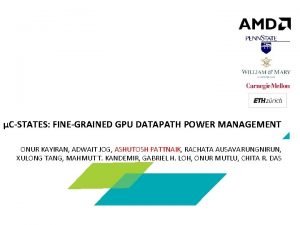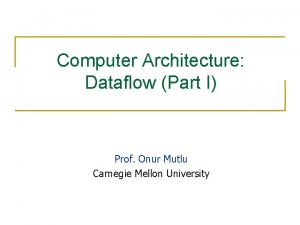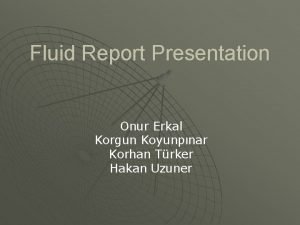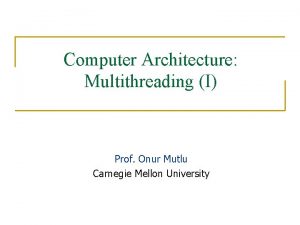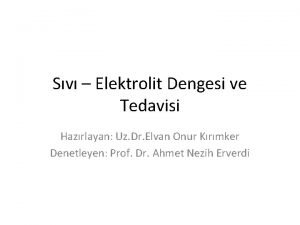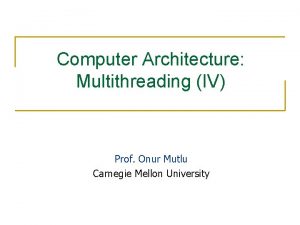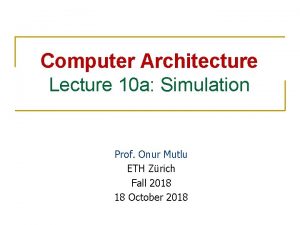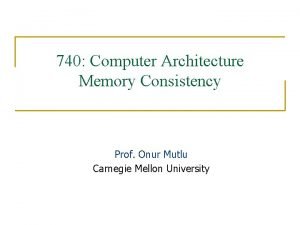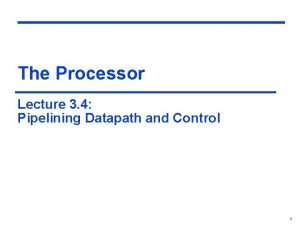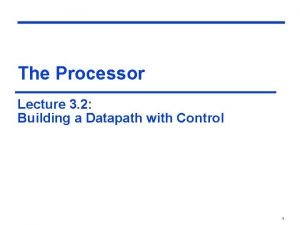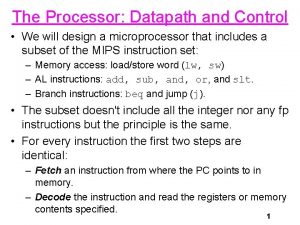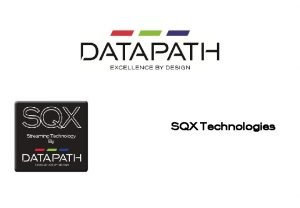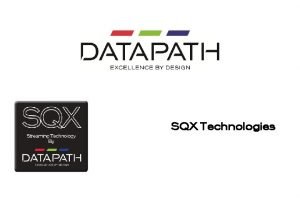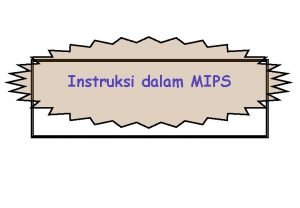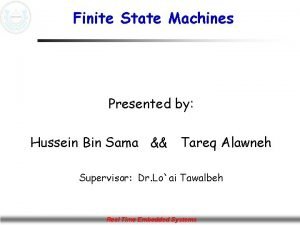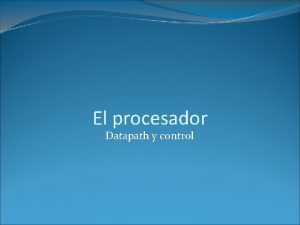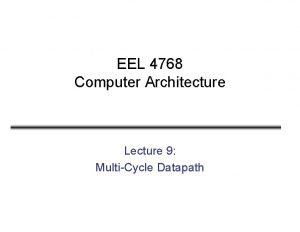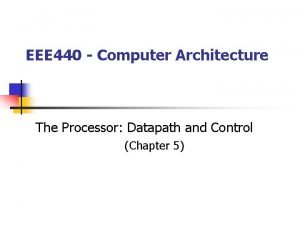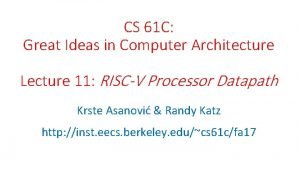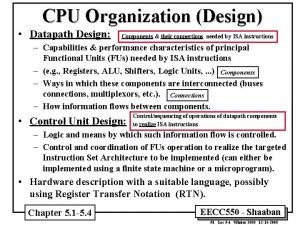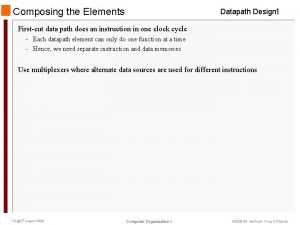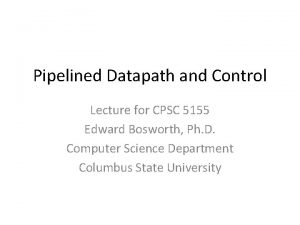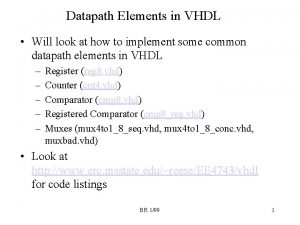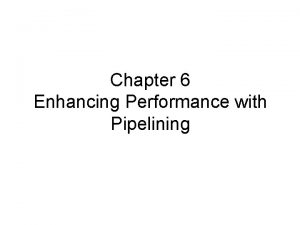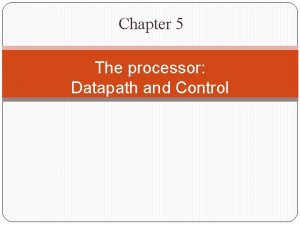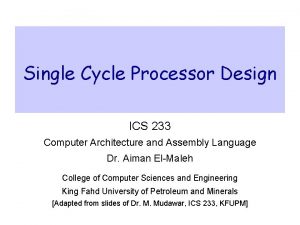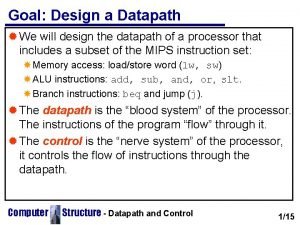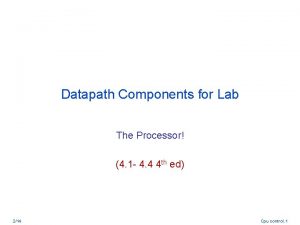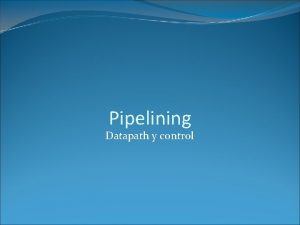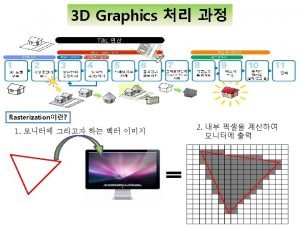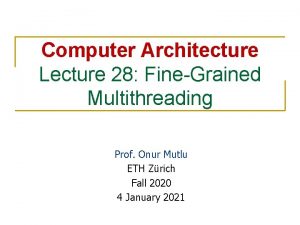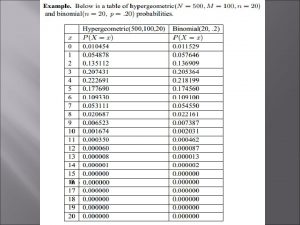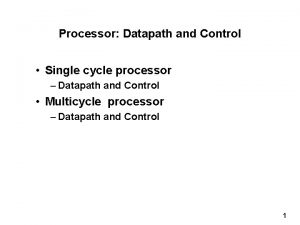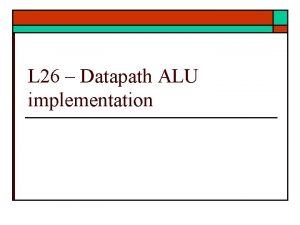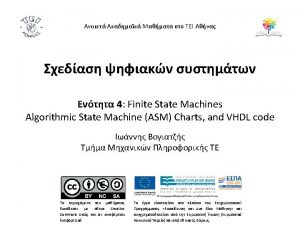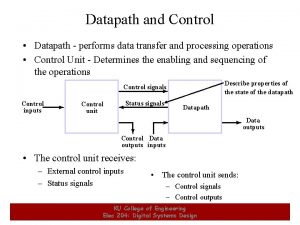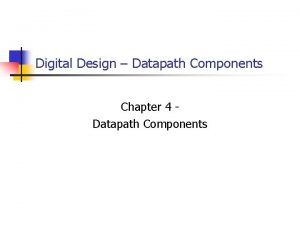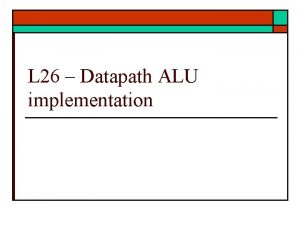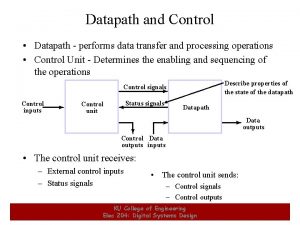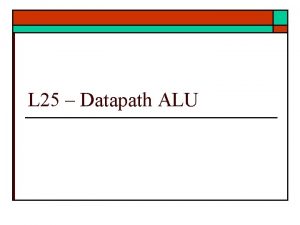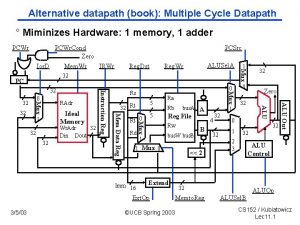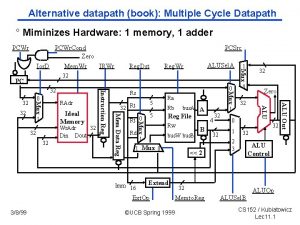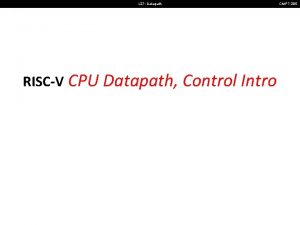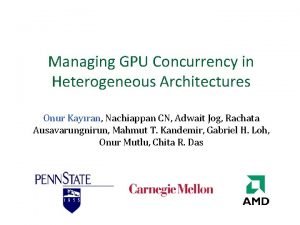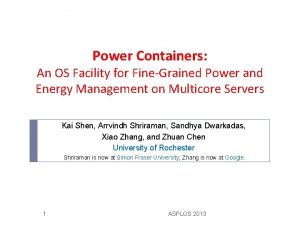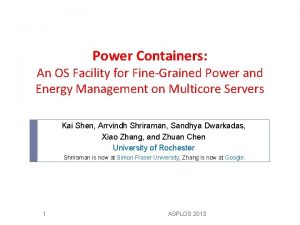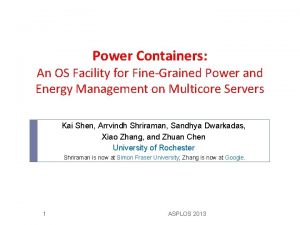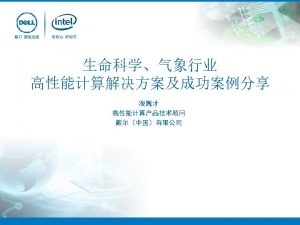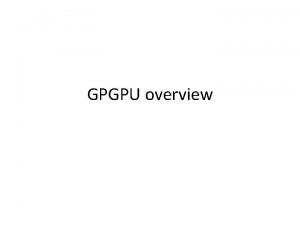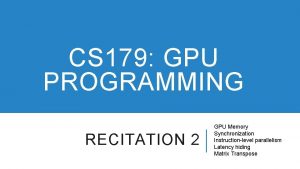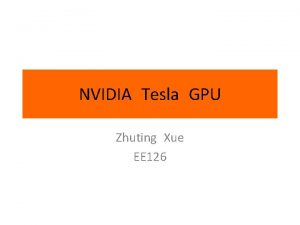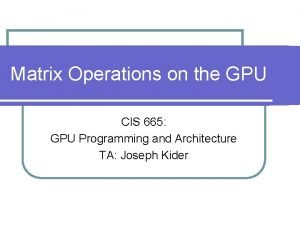CSTATES FINEGRAINED GPU DATAPATH POWER MANAGEMENT ONUR KAYIRAN






































- Slides: 38

µC-STATES: FINE-GRAINED GPU DATAPATH POWER MANAGEMENT ONUR KAYIRAN, ADWAIT JOG, ASHUTOSH PATTNAIK, RACHATA AUSAVARUNGNIRUN, XULONG TANG, MAHMUT T. KANDEMIR, GABRIEL H. LOH, ONUR MUTLU, CHITA R. DAS

EXECUTIVE SUMMARY The peak throughput and individual capabilities of the GPU cores are increasing ‒ Lower and imbalanced utilization of datapath components We identify two key problems: ‒ Wastage of datapath resources and increased static power consumption ‒ Performance degradation due to contention in memory hierarchy Our Proposal - µC-States: - A fine-grained dynamic power- and clock-gating mechanism for the entire datapath based on queuing theory principles - Reduces static and dynamic power, improves performance 2

BIG CORES VS. SMALL CORES SLA & MM Normalized Value 1. 5 1. 25 IPC Leakage 1 ‒ Performance ‒ Leakage power SCAN & SSSP ‒ Performance ‒ Leakage power 0. 75 0. 5 SLA MM SCAN SSSP BLK SCP BLK & SCP ‒ Performance ‒ Leakage power 3

OUTLINE Summary Background Motivation and Analysis Our Proposal Evaluation Conclusions 4

BACKGROUND A HIGH-END GPU DATAPATH Per GPU core: ‒ 4 wavefront schedulers ‒ 64 shader processors ‒ 32 LD/ST units Evaluation of larger GPU cores Instruction Cache Wavefront Scheduler Dispatch Unit Register File SP SP SP SP SP SP LD/ST LD/ST LD/ST LD/ST SP SP SP SP LD/ST SP SP LD/ST SP SP SP SP Interconnect Network Shared Memory/L 1 Cache Constant Cache Texture Cache 5 Wavefront Scheduler Dispatch Unit LD/ST LD/ST LD/ST SFU SFU

BACKGROUND ANALYZING CORE BOTTLENECKS Fetch/Decode (IFID) Wavefront Scheduler (SCH) IDOCSP OCEXSP IDOCSFU OCEXSFU IDOCLDST OCEXLDST Pipeline Register Operand Collector Pipeline Register The datapath can be modeled as a simple queuing system ‒ Component with the highest utilization is the bottleneck Utilization Law [Jain, 1991]: ‒ Utilization = Service time * Throughput ‒ SP and SFU units have deterministic service times ‒ LD/ST unit waits for response from the memory system ‒ Used to calculate the component with highest utilization Little’s Law [Little, OR 1961]: 6 ‒ Number of jobs in the system = Arrival rate * Response time ‒ Response time includes queuing delays ‒ Used to estimate Response Time of memory instructions in LD/ST unit Execution Unit

BACKGROUND POWER- AND CLOCK-GATING Power-gating reduces static power Clock-gating reduces dynamic power Power-gating leads to loss of data ‒ Employ clock-gating for: ‒ Instruction buffer, pipeline registers, register file banks, and LD/ST queue Power-gating overheads ‒ Wake-up delay: Time to power on a component ‒ Break-even time: Shortest time to power-gate to compensate for the energy overhead 7

OUTLINE Summary Background Motivation and Analysis Our Proposal Evaluation Conclusions 8

MOTIVATION AND ANALYSIS ALU AND LDST UTILIZATION W/ REAL EXPERIMENTS NVIDIA K 20 GPU NVIDIA GTX 660 GPU 10 9 8 LDST Utilization 7 6 5 4 Low ALU utilization High LD/ST unit utilization 3 2 1 0 0 9 1 2 3 4 5 6 7 ALU Utilization 8 9 10

MOTIVATION AND ANALYSIS PER-COMPONENT UTILIZATION W/ SIMULATION Low ALU utilization Potential bottlenecks 10 High LD/ST unit utilization

MOTIVATION AND ANALYSIS APPLICATION SENSITIVITY TO DATAPATH COMPONENTS Fetch/Decode (IFID) Wavefront Scheduler (SCH) IDOCSP OCEXSP IDOCSFU OCEXSFU IDOCLDST OCEXLDST Pipeline Register Operand Collector Pipeline Register Compute-intensive application 11 Execution Unit

MOTIVATION AND ANALYSIS APPLICATION SENSITIVITY TO DATAPATH COMPONENTS Fetch/Decode (IFID) Wavefront Scheduler (SCH) IDOCSP OCEXSP IDOCSFU OCEXSFU IDOCLDST OCEXLDST Pipeline Register Operand Collector Pipeline Register Compute-intensive application ‒ Halving the width of the red components -> No performance impact ‒ Halving the width of all components -> 30% lower performance Many components are critical for performance 12 Execution Unit

MOTIVATION AND ANALYSIS APPLICATION SENSITIVITY TO DATAPATH COMPONENTS Fetch/Decode (IFID) Wavefront Scheduler (SCH) IDOCSP OCEXSP IDOCSFU OCEXSFU IDOCLDST OCEXLDST Pipeline Register Operand Collector Pipeline Register Application with LD/ST unit bottleneck 13 Execution Unit

MOTIVATION AND ANALYSIS APPLICATION SENSITIVITY TO DATAPATH COMPONENTS Fetch/Decode (IFID) Wavefront Scheduler (SCH) IDOCSP OCEXSP IDOCSFU OCEXSFU IDOCLDST OCEXLDST Pipeline Register Operand Collector Pipeline Register Application with LD/ST unit bottleneck ‒ Halving the width of the blue components -> No performance impact 14 Execution Unit

MOTIVATION AND ANALYSIS APPLICATION SENSITIVITY TO DATAPATH COMPONENTS Fetch/Decode (IFID) Wavefront Scheduler (SCH) IDOCSP OCEXSP IDOCSFU OCEXSFU IDOCLDST OCEXLDST Pipeline Register Operand Collector Pipeline Register Application with LD/ST unit bottleneck ‒ Halving the width of the blue components -> No performance impact ‒ Halving the width of the blue + red components -> 4% performance loss 15 Execution Unit

MOTIVATION AND ANALYSIS APPLICATION SENSITIVITY TO DATAPATH COMPONENTS Fetch/Decode (IFID) Wavefront Scheduler (SCH) IDOCSP OCEXSP IDOCSFU OCEXSFU IDOCLDST OCEXLDST Pipeline Register Operand Collector Pipeline Register Execution Unit Application with LD/ST unit bottleneck ‒ Halving the width of the blue components -> No performance impact ‒ Halving the width of the blue + red components -> 4% performance loss ‒ Halving the width of the blue + red components + LD/ST unit -> 35% performance loss LD/ST unit is the bottleneck 16

MOTIVATION AND ANALYSIS APPLICATION SENSITIVITY TO DATAPATH COMPONENTS Fetch/Decode (IFID) Wavefront Scheduler (SCH) IDOCSP OCEXSP IDOCSFU OCEXSFU IDOCLDST OCEXLDST Pipeline Register Operand Collector Pipeline Register Application with memory system bottleneck ‒ Similar to QTC, but it has very high memory response time 17 Execution Unit

MOTIVATION AND ANALYSIS APPLICATION SENSITIVITY TO DATAPATH COMPONENTS Fetch/Decode (IFID) Wavefront Scheduler (SCH) IDOCSP OCEXSP IDOCSFU OCEXSFU IDOCLDST OCEXLDST Pipeline Register Operand Collector Pipeline Register Application with memory system bottleneck ‒ Similar to QTC, but it has very high memory response time ‒ Halving the width of LD/ST unit does not degrade performance 18 Execution Unit

MOTIVATION AND ANALYSIS APPLICATION SENSITIVITY TO DATAPATH COMPONENTS Fetch/Decode (IFID) Wavefront Scheduler (SCH) IDOCSP OCEXSP IDOCSFU OCEXSFU IDOCLDST OCEXLDST Pipeline Register Operand Collector Pipeline Register Execution Unit Application with memory system bottleneck Memory system is the bottleneck, not the LD/ST unit. Higher issue width degrades performance! ‒ Similar to QTC, but it has very high memory response time ‒ Halving the width of LD/ST unit does not degrade performance ‒ Halving the width of the wavefront scheduler -> 19% performance improvement 19

MOTIVATION AND ANALYSIS APPLICATIONS WITH MEMORY SYSTEM BOTTLENECK 1. 5 Normalized performance Normalized stall cycles per L 1 miss 1 0. 5 0 BLK SCP RED RAY TRA SPMV ST 2 D PVC LIB JPEG In memory-bound applications, performance degrades with the increase in L 1 stalls 20

MOTIVATION AND ANALYSIS APPLICATIONS WITH MEMORY SYSTEM BOTTLENECK Single issue width Double issue width Time unit 1 Time unit 2 time Wavefront 1 W 1 -R 1 Wavefront 2 W 2 -R 1 Wavefront 1 time W 1 -R 2 W 2 -R 2 2 outstanding requests / unit time 3 outstanding requests / unit time Instruction latency = 1 time unit More contention Instruction latency > 2 time units When memory system is the bottleneck, The problem aggravates with higher issue width might degrade performance! divergent applications 21

MOTIVATION AND ANALYSIS KEY INSIGHTS Observation: Low ALU utilization, high LD/ST unit utilization Compute-intensive applications: Bottleneck can be fetch/decode units, wavefronts schedulers, or execution units Memory-intensive applications: Bottleneck can be the LD/ST unit, or the memory system Applications with memory system bottleneck: Divergent applications can lose performance with high issue width 22

OUTLINE Summary Background Motivation and Analysis Our Proposal Evaluation Conclusions 23

µC-STATES KEY IDEAS Goal: ‒ To reduce the static and dynamic power of the GPU core pipeline ‒ To maintain, and when possible improve performance Power benefits: ‒ Based on bottleneck analysis ‒ Power- or clock-gates components that are not critical for performance ‒ Employs clock-gating for components that hold execution state, or hold data for long periods Performance benefits: ‒ Reducing issue width when memory system is the bottleneck improves performance ‒ Only half the width of each component is gated 24

µC-STATES ALGORITHM DETAILS Periodically goes through three phases First phase: Execution units and LD/ST unit ‒ Power-gates execution units with low utilization ‒ Clock-gates LD/ST units when memory response time (estimated by Little’s Law) is high Second phase: Register file banks and pipeline registers ‒ Compares the utilization of each component with its corresponding execute stage unit ‒ If lower, they are not bottleneck, and can be gated-off Third phase: Wavefront scheduler and fetch/decode units ‒ Compares scheduler utilization to cumulative executive stage utilization ‒ If lower, issue width is halved ‒ If fetch/decode utilization is lower than scheduler’s, fetch/decode width is halved P IFID C SCH P IDOCSP C OCEXSP C EXSP P IDOCSFUC OCSFU C OCEXSFUC EXSFU P C C IDOCLDST OCEXLDST Phase 1 Phase 2 Phase 3 25 Gating Controller

µC-STATES MORE IN THE PAPER Employed at coarse time granularity Not sensitive to overheads related to entering or exiting power-gating states Independent of the underlying wavefront scheduler Issue width sizing is fundamentally different than thread-level parallelism management ‒ Comparison to CCWS [Rogers+, MICRO 2012] 26

OUTLINE Summary Background Motivation and Analysis Our Proposal Evaluation Conclusions 27

EVALUATION METHODOLOGY We simulate the baseline architecture using a modified version of GPGPU-Sim v 3. 2. 2 that allows larger GPU cores GPU-Wattch ‒ Reports dynamic power ‒ Area calculations for static power ‒ Conservative assumption of non-core components, such as the memory subsystem and DRAM, to contribute to 40% of static power Baseline architecture ‒ 16 Shader Cores, SIMT Width = 32 × 4 ‒ 36 K Registers, 16 k. B L 1 cache, 48 k. B shared memory ‒ GTO wavefront scheduler ‒ 6 shared GDDR 5 MCs 28

RESULTS SUMMARY POWER SAVINGS u. C-States 1 7% dynamic power savings 11% total power savings for the chip GMEAN 0. 75 0. 5 29 C_HALF 16% static power savings BFS BLK JPEG LIB MUM NN RAY SCP SLA TRA FWT BP BTR HOT HW LAV PATH MM SAD SPMV PVC PVR MD QTC RED SCAN SPMV-S ST 2 D TRD BH DMR MST SP SSSP Normalized Static Power All components are half-width

RESULTS SUMMARY PERFORMANCE All components are half-width C_HALF 1. 4 1. 2 1 0. 8 0. 6 0. 4 0. 2 10% performance improvement over C_HALF 2% performance improvement over the baseline 9% performance improvement for applications with memory system bottleneck 30 GMEAN 0 BFS BLK JPEG LIB MUM NN RAY SCP SLA TRA FWT BP BTR HOT HW LAV PATH MM SAD SPMV PVC PVR MD QTC RED SCAN SPMV-S ST 2 D TRD BH DMR MST SP SSSP Normalized Performance u. C-States

RESULTS SUMMARY HETEROGENEOUS-CORE GPUS A system with 8 small and 8 big cores Performs as good as 16 big cores Has smaller power consumption and area than the 16 -core system Heterogeneous 1. 2 Normalized Performance Performs better than 16 small cores C_Half 1 0. 8 0. 6 0. 4 0. 2 31 GMEAN FWT_NN FWT_SAD FWT_MM SCP_NN SCP_SAD SCP_MM BLK_NN BLK_SAD BLK_MM 0

OUTLINE Summary Background Motivation and Analysis Our Proposal Evaluation Conclusions 32

CONCLUSIONS Many GPU datapath components are heavily underutilized More resources in a GPU core can sometimes degrade performance because of contention in the memory system µC-States minimizes power consumption by turning off datapath components that are not performance bottlenecks, and improves performance for applications with memory system bottleneck Our analysis could be useful in guiding scheduling and design decisions in a heterogeneous-core GPU with both small and big cores Our analysis and proposal can be useful for developing other new analyses and optimization techniques for more efficient GPU and heterogeneous 33 architectures

Thanks! Questions? µC-STATES: FINE-GRAINED GPU DATAPATH POWER MANAGEMENT ONUR KAYIRAN, ADWAIT JOG, ASHUTOSH PATTNAIK, RACHATA AUSAVARUNGNIRUN, XULONG TANG, MAHMUT T. KANDEMIR, GABRIEL H. LOH, ONUR MUTLU, CHITA R. DAS

Backup

37 SSSP MST BH ST 2 D SCAN QTC MFLP EX_SFU PVR SPMV MM EX_SP PATH HW SCH GSS BP IFID TRA SLA RAY MUM JPEG BFS Average time the units are on ADDITIONAL RESULTS AVERAGE TIME THE UNITS ARE ON EX_LDST 1 0. 8 0. 6 0. 4 0. 2 0

0% 38 IFID SCH EX_SP AVG BFS BLK JPEG LIB MUM NN RAY SCP SLA TRA FWT BP BTR HOT HW LAV PATH MM SAD SPMV PVC PVR MD QTC RED SCAN SPMV-S ST 2 D TRD BH DMR MST SP SSSP Savings Breakdown ADDITIONAL RESULTS SAVINGS BREAKDOWN EX_SFU 120% 100% 80% 60% 40% 20%

DISCLAIMER & ATTRIBUTION The information presented in this document is for informational purposes only and may contain technical inaccuracies, omissions and typographical errors. The information contained herein is subject to change and may be rendered inaccurate for many reasons, including but not limited to product and roadmap changes, component and motherboard version changes, new model and/or product releases, product differences between differing manufacturers, software changes, BIOS flashes, firmware upgrades, or the like. AMD assumes no obligation to update or otherwise correct or revise this information. However, AMD reserves the right to revise this information and to make changes from time to the content hereof without obligation of AMD to notify any person of such revisions or changes. AMD MAKES NO REPRESENTATIONS OR WARRANTIES WITH RESPECT TO THE CONTENTS HEREOF AND ASSUMES NO RESPONSIBILITY FOR ANY INACCURACIES, ERRORS OR OMISSIONS THAT MAY APPEAR IN THIS INFORMATION. AMD SPECIFICALLY DISCLAIMS ANY IMPLIED WARRANTIES OF MERCHANTABILITY OR FITNESS FOR ANY PARTICULAR PURPOSE. IN NO EVENT WILL AMD BE LIABLE TO ANY PERSON FOR ANY DIRECT, INDIRECT, SPECIAL OR OTHER CONSEQUENTIAL DAMAGES ARISING FROM THE USE OF ANY INFORMATION CONTAINED HEREIN, EVEN IF AMD IS EXPRESSLY ADVISED OF THE POSSIBILITY OF SUCH DAMAGES. ATTRIBUTION © 2013 Advanced Micro Devices, Inc. All rights reserved. AMD, the AMD Arrow logo and combinations thereof are trademarks of Advanced Micro Devices, Inc. in the United States and/or other jurisdictions. SPEC is a registered trademark of the Standard Performance Evaluation Corporation (SPEC). Other names are for informational purposes only and may be trademarks of their respective owners. 39
 Onur kayiran
Onur kayiran Onur alakas
Onur alakas Onur mutlu computer architecture
Onur mutlu computer architecture Dr hasan onur yavuz
Dr hasan onur yavuz Onur erkal
Onur erkal Onur mutlu computer architecture
Onur mutlu computer architecture Elvan onur kırımker
Elvan onur kırımker Abbas polat
Abbas polat Tıbbi atık ambleminin bulunması zorun olan alanlar
Tıbbi atık ambleminin bulunması zorun olan alanlar Prof. onur mutlu
Prof. onur mutlu Onur mutlu computer architecture
Onur mutlu computer architecture Mirabegron etki mekanizması
Mirabegron etki mekanizması Onur mutlu computer architecture
Onur mutlu computer architecture Ac power formula
Ac power formula Pipelined datapath
Pipelined datapath Building a datapath
Building a datapath Datapath
Datapath Datapath sqx
Datapath sqx Datapath sqx
Datapath sqx Color 27042008
Color 27042008 Finite state machine with datapath
Finite state machine with datapath Que es un datapath
Que es un datapath Arquitectura de computadoras
Arquitectura de computadoras Difference between single cycle and multicycle datapath
Difference between single cycle and multicycle datapath Basic mips implementation in computer architecture
Basic mips implementation in computer architecture Jalr datapath
Jalr datapath Jal datapath
Jal datapath Datapath vt
Datapath vt Lc3 datapath
Lc3 datapath Datapath adalah
Datapath adalah Pipelined datapath
Pipelined datapath Datapath que es
Datapath que es Datapath vhdl
Datapath vhdl Pipelined datapath
Pipelined datapath Lui datapath
Lui datapath Single cycle datapath
Single cycle datapath Sll single cycle datapath
Sll single cycle datapath Alu datapath
Alu datapath Datapath components
Datapath components
